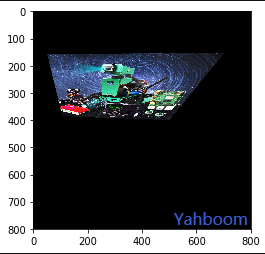Perspective transformation
Perspective transformation is also called projection transformation. The affine transformation we often talk about is a special case of perspective transformation. The purpose of perspective transformation is to transform objects that are straight lines in reality into straight lines in the picture. Perspective transformation can map a rectangle to an arbitrary quadrilateral.
This technology is used when the robot is driving automatically. Perspective transformation is done through the function:
dst = cv2. warpPerspective(src, M, dsize[,flag, [,borderMode[,borderValue]]])
dst : The output image after perspective transformation, dsize determines the actual size of the output.
src: Source Image
M:3X3 transformation matrix
dsize: Output image size.
flags: Interpolation method, the default is INTER_LINEAR (bilinear interpolation). When it is WARP_INVERSE_MAP, it means that M is an inverse transformation, which can achieve the inverse transformation from the target dst to src.
borderMode: The edge type. The default is BORDER_CONSTANT. When the value is BORDER_TRANSPARENT, the values in the target image are not changed, and these values correspond to the outliers in the original image.
borderValue: Boundary value, the default is 0. Like affine transformation, OpenCV still provides a function cv2.getPerspectiveTransform() to provide the transformation matrix above.
The function is as follows.
matAffine = cv2.getPerspectiveTransform(matSrc, matDst)
matSrc: The coordinates of the four vertices of the input image.
matDst: Output the coordinates of the four vertices of the image.
Code path:
x~/dofbot_pro/dofbot_opencv/scripts/2.Transform/07_perspectivity.ipynb
ximport cv2import numpy as npimport matplotlib.pyplot as pltimg = cv2.imread('yahboom.jpg',1)
imgInfo = img.shapeheight = imgInfo[0]width = imgInfo[1]#src 4->dst 4 (Upper left corner, Lower left corner, Upper right corner, Lower right corner)matSrc = np.float32([[200,100],[200,400],[600,100],[width-1,height-1]])matDst = np.float32([[200,200],[200,300],[500,200],[500,400]])#Combination
matAffine = cv2.getPerspectiveTransform(matSrc,matDst)# mat 1 src 2 dstdst = cv2.warpPerspective(img,matAffine,(width,height))img_bgr2rgb = cv2.cvtColor(dst, cv2.COLOR_BGR2RGB)plt.imshow(img_bgr2rgb) plt.show()